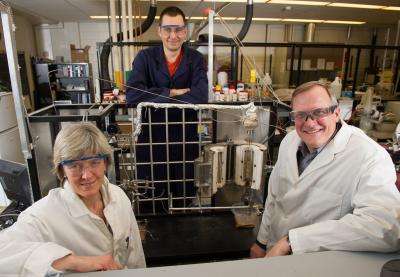Research shows promise for reducing greenhouse gases

University of Calgary scientists are investigating how 'Alberta-grown' biomass – such as straw and wood left over from agricultural and forestry operations – could be used to clean up chemical contaminants in water from oilsands operations.
"It's important to look at areas of synergy for these industries," says project lead David Layzell, a University of Calgary biological sciences professor affiliated with the Institute for Sustainable Energy, Environment and Economy.
"We can get a bigger bang for the buck by getting our agriculture and forestry sectors to help the oil and gas sector solve some of its environmental problems," Layzell says.
This research project received $57,500 from the Climate Change and Emissions Management (CCEMC) Corporation though the Biological Greenhouse Gas Management Program. The program is managed on behalf of CCEMC by Alberta Innovates Bio Solutions.
Alberta's oilsands mining industry currently uses about 123 million cubic metres of water annually that ends up in large tailings ponds.
The organic compounds in this processed water are dominated by naphthenic acids, which are toxic and corrosive. In addition, microbes in the ponds convert these naphthenic acids to methane gas, which is emitted to the atmosphere. Methane is a greenhouse gas that has about 25 times more warming potential in Earth's atmosphere than carbon dioxide.
University of Calgary researchers aim to develop an activated biocarbon tailored for adsorbing the naphthenic acids in tailings pond water, thereby preventing the formation and release of methane greenhouse gasses.
In addition, the spent biocarbon could be used as either a source of renewable energy to displace fossil fuels, or land-filled as a permanent carbon storage – further reducing greenhouse gas emissions.
"This would give us a low-cost greenhouse gas advantage from using a bioproduct, while also reducing the oil sands industry's environmental footprint," Layzell notes.
The project is based on a previous study led by Layzell that was supported by companies in the Oil Sands Leadership Initiative and by the Natural Sciences and Engineering Resource Council of Canada.
That initial study showed activated carbon products, such as those currently being used in kitchen water filters and industrial filtration systems were very effective at removing organics from water obtained from oilsands operations.
"Given that finding, we are working to develop a novel way of making an activated or adsorbing biocarbon that would have the chemical properties of commercial products, but can be produced at large scale from Alberta-grown biomass with much lower energy input and economic cost," Layzell says.
Layzell is currently collaborating with colleagues Josephine Hill, a chemical and petroleum engineering professor in the Schulich School of Engineering, and Andrei Veksha, a post-doctoral researcher at the Schulich School of Engineering who has expertise in making activated carbons.
The researchers have successfully made small amounts of biocarbon from aspen residues using "slow pyrolysis," a relatively low-temperature process that 'burns' the biomass in the absence of oxygen.
"We're looking for a cheaper process with lower energy input to make the activated biochar. This would minimize the cost per cubic metre of using it to treat oilsands water, while also maximizing the greenhouse gas benefit," Hill says. "Our preliminary results are promising."
The team, which has held several meetings with industry experts, will need to show they can scale up their laboratory process and also do economics analysis to ensure their final products are cost-efficient for the oilsands industry.
"It's a win-win-win potential," Layzell says. "We create a new market for agricultural and forest products. As a result, a new industry emerges that links the agriculture and forest industries to solving the oil and gas industry's environmental problems . . . and we can significantly reduce our carbon footprint."
Provided by University of Calgary

















